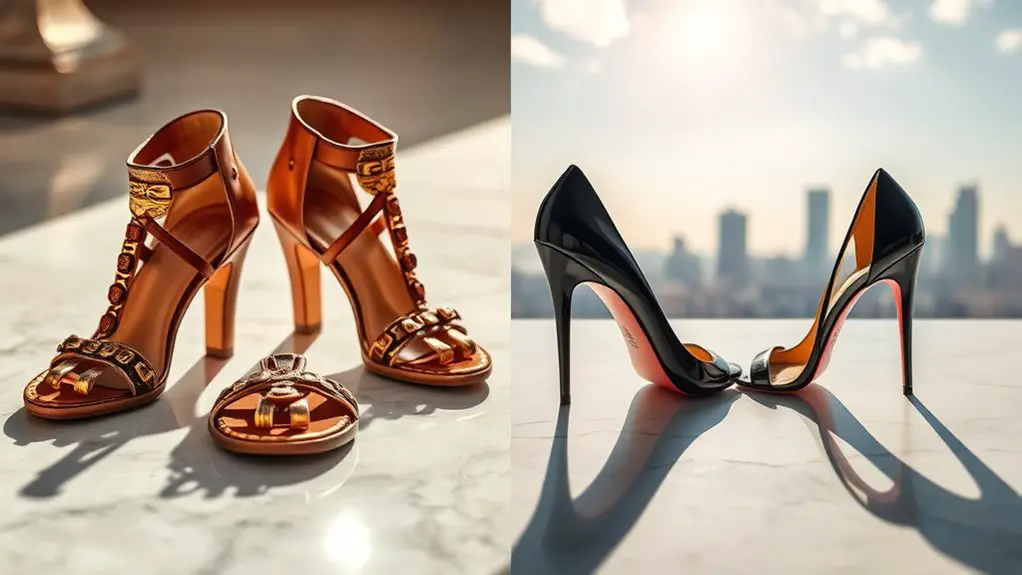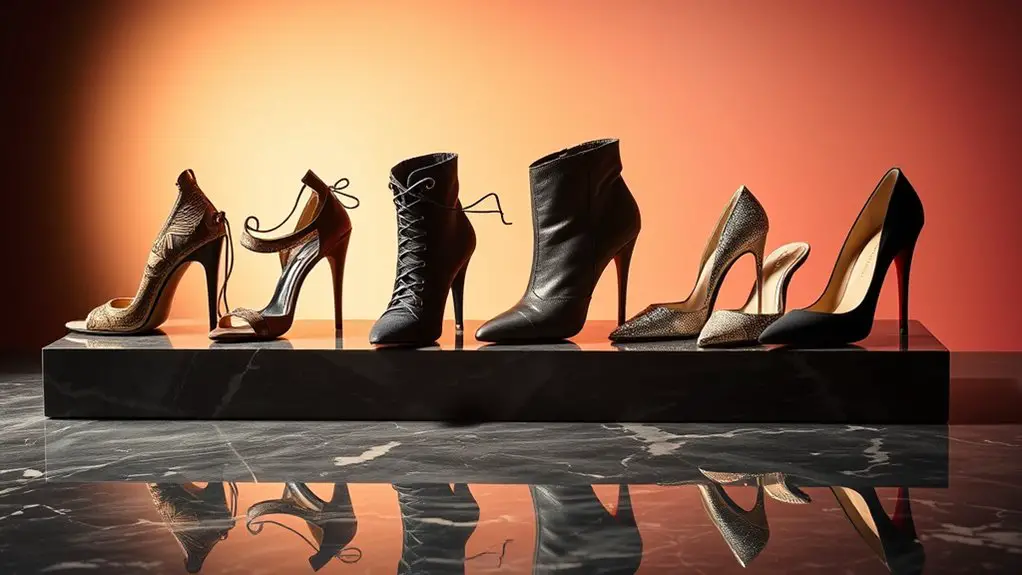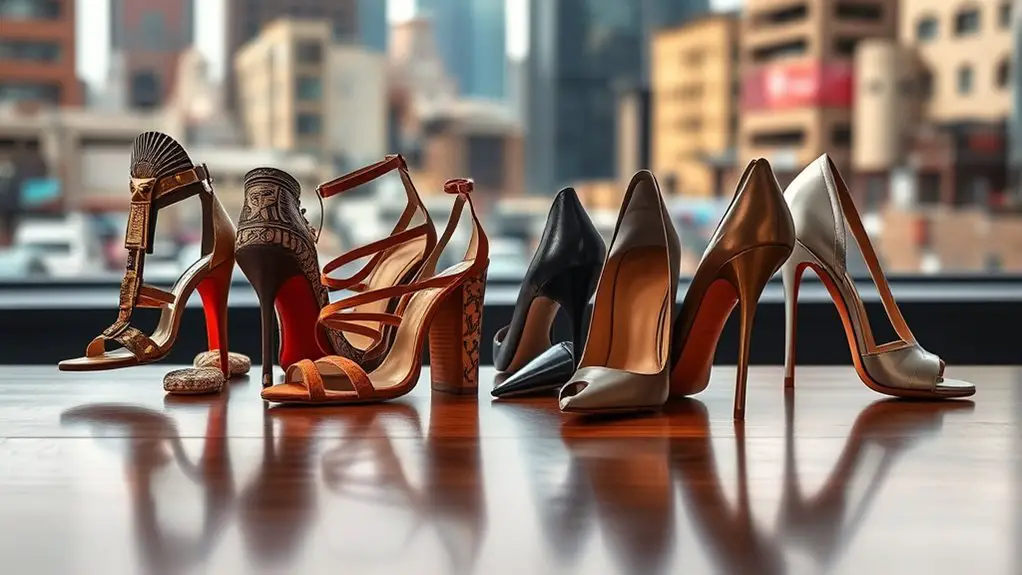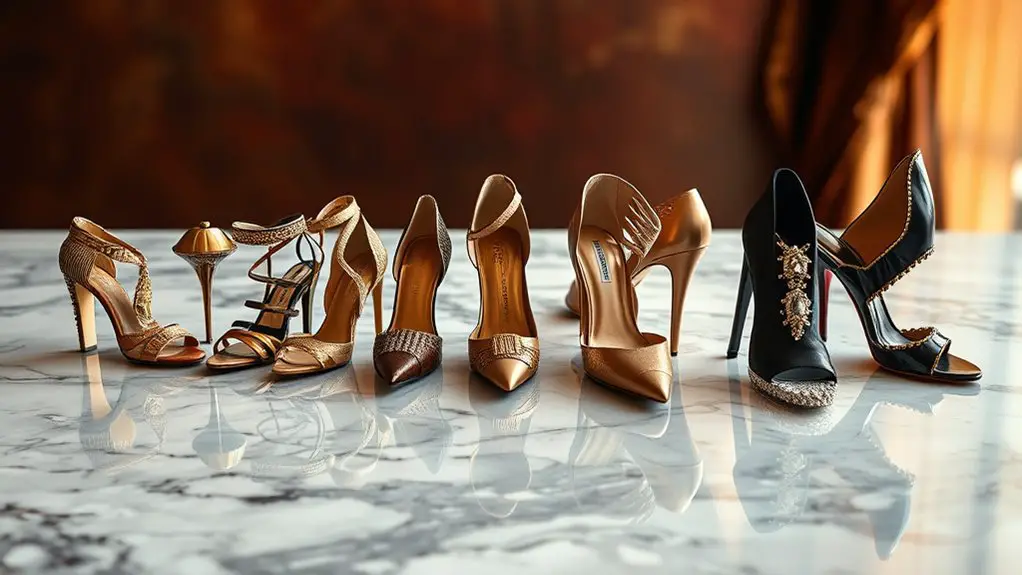Heels have evolved considerably over the centuries. In ancient times, they served practical purposes, protecting feet from dirt and offering stability for horse riders. By the Renaissance, they became status symbols among aristocrats, showcasing wealth and power. The 20th century marked a shift as women embraced heels for empowerment and self-expression. Today, you’ll find a diverse range of heel designs that combine style with comfort, reflecting personal identities and cultural narratives, hinting at a deeper story to explore.
The Origins of High Heels: Ancient Civilizations and Practicality

Although you might associate high heels with modern fashion, their origins date back to ancient civilizations where practicality drove their design. In ancient cultures, footwear served a functional purpose; heels often elevated wearers above dirt and debris, aiding in mobility across uneven terrain. Ancient footwear, such as the Egyptian sandals, featured elevated soles that not only offered protection but also facilitated walking in sandy environments.
In the Persian Empire, soldiers wore heels to maintain stability while riding horses, showcasing how practical designs were integral to their daily lives. Similarly, in ancient Rome, elevated footwear signified different social classes, further intertwining function with societal norms.
Thus, the evolution of high heels began not as a fashion statement but as a necessity, demonstrating how ancient civilizations prioritized practical designs in their quest for comfort and utility. Understanding this context enriches your appreciation of heels today.
The Renaissance Era: Heels as a Symbol of Status
As society shifted into the Renaissance era, heels evolved from mere functional footwear to potent symbols of status and wealth. You’d notice how the fashion hierarchy began to reflect one’s social standing, with heels becoming an essential element of aristocratic attire. The royal influence was undeniable; nobility adopted elevated shoes to distinguish themselves from the common folk.
These ornate heels, often adorned with intricate designs and vibrant colors, weren’t just about height—they signified power and prestige. Men and women alike embraced this trend, using heels to project an image of sophistication. The higher the heel, the greater the status, creating a visual representation of one’s place in society.
As you walk through the opulent courts of the time, it’s clear that heels were more than just a fashion statement; they were a means of asserting dominance in a world where appearance dictated one’s standing.
The Rise of Women in Heels: Feminine Empowerment in the 20th Century

With the end of the Victorian era and the onset of the 20th century, heels took on a new significance, particularly for women. As you stepped into this transformative time, heels became more than just footwear; they symbolized feminine empowerment. Women began to challenge societal expectations, using heels to assert their independence and break free from traditional roles. The rise of the flapper in the 1920s exemplified this shift, as women embraced a more liberated identity, choosing to wear heels that complemented their newfound freedom.
Heels became a tool for self-expression, allowing you to convey confidence and assertiveness in a male-dominated society. As women entered the workforce and sought equal rights, the act of wearing heels transformed into a statement of strength. In this evolving landscape, heels not only shaped your physical appearance but also embodied the spirit of empowerment, reshaping perceptions of femininity for generations to come.
Modern Innovations: The Diversity of Heel Designs Today
The world of heels has undergone remarkable transformations in recent years, reflecting a blend of innovation and personal expression. Today, you’ll find a variety of heel designs that cater to both style and comfort. Brands are increasingly prioritizing sustainable materials, ensuring that fashion choices align with eco-conscious values. Ergonomic designs are also making strides, allowing you to enjoy elevation without sacrificing comfort.
| Heel Type | Features | Ideal Use |
|---|---|---|
| Block Heel | Stability, wider base | Daily wear |
| Stiletto | Slim, elongated silhouette | Formal occasions |
| Wedge | Even weight distribution | Casual outings |
| Platform | Added height with comfort | Nightlife and parties |
This diversity in heel designs not only enhances your wardrobe but also encourages mindful fashion choices. Whether you prefer a chic stiletto or a comfortable block heel, there’s a perfect pair for you.
Cultural Significance: Heels in Fashion and Identity in the 21st Century

Heels have evolved beyond mere fashion statements; they now embody complex cultural narratives and personal identities in the 21st century. As you navigate today’s fashion landscape, you’ll notice how heels reflect not only trends but also cultural identity. For many, wearing heels signifies empowerment and confidence, while for others, it can represent societal pressure and conformity.
The fashion evolution surrounding heels is remarkable; they’ve shifted from symbols of status to tools of self-expression. In diverse communities, specific styles can resonate deeply, fostering a sense of belonging or challenging traditional norms.
Social media amplifies this cultural significance, allowing individuals to showcase their unique interpretations of heels, thereby reshaping the conversation around femininity and style. Whether you see them as a means of empowerment or a point of contention, heels undeniably connect personal expression with broader cultural narratives, making them a fascinating subject in contemporary fashion discourse.
Frequently Asked Questions
What Materials Are Commonly Used in Modern Heel Construction?
When you step into modern heels, you’ll find a blend of synthetic materials and sustainable practices. Designers increasingly prioritize eco-friendly options, ensuring comfort and style without sacrificing ethical considerations in heel construction. Isn’t that invigorating?
How Do Heels Affect Posture and Foot Health?
Heels greatly impact your posture alignment, altering heel biomechanics. Wearing them can lead to imbalances, affecting your spine and joints. It’s essential to take into account these factors for long-term foot health and overall well-being.
What Are the Most Popular Heel Heights Today?
You’d think towering stilettos rule today, but platform styles and casual options are stealing the spotlight. Heels range from barely-there to chunky heights, balancing comfort with that ever-elusive desire to impress.
Are There Any Famous Historical Figures Known for Wearing Heels?
When you think of famous figures in heels, Louis XIV’s extravagant styles and Marlene Dietrich’s bold fashion choices come to mind. Both utilized heels to convey power and challenge gender norms, leaving a lasting impression on fashion history.
How Have Heels Influenced Men’s Fashion Over Time?
Heels have challenged gender norms, transforming men’s fashion from practical to flamboyant. They’ve served as bold fashion statements, allowing you to express individuality, while simultaneously reshaping perceptions of masculinity throughout different historical contexts and social movements.



